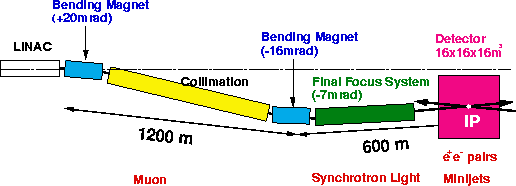In order to see where the background comes from, the beam line from the exit of
main linear accelerator(linac) to the interaction point(IP) is shown in
Fig.2 for JLC-I(![]() 500GeV). [2]
A bending magnet of +20mrad, which is the so-called big bend, is needed because the
background from the upstream linac can not directly hit a detector. The second bending
magnet of -16mrad makes a horizontal crossing of
500GeV). [2]
A bending magnet of +20mrad, which is the so-called big bend, is needed because the
background from the upstream linac can not directly hit a detector. The second bending
magnet of -16mrad makes a horizontal crossing of ![]() mrad between two beams at IP.
There are two major sections of 1200m collimation and a 600m final focus
system in the beam line, where (1)muons and (2)synchrotron radiation are produced,
respectively. At IP, (3)
mrad between two beams at IP.
There are two major sections of 1200m collimation and a 600m final focus
system in the beam line, where (1)muons and (2)synchrotron radiation are produced,
respectively. At IP, (3)![]() pairs and (4)minijets are created in beam-beam
interactions. In the subsequent sections these four kinds of background are
briefly discussed together with the possible designs of an interaction region against
them.
pairs and (4)minijets are created in beam-beam
interactions. In the subsequent sections these four kinds of background are
briefly discussed together with the possible designs of an interaction region against
them.

Figure 2:
Top view of the beam line from the exit of the main linac to the
interaction point (IP) of JLC-I(![]() 500GeV).
500GeV).